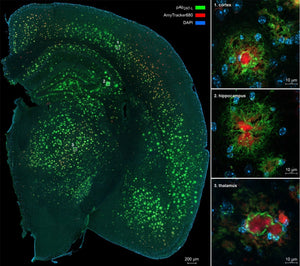
Understanding how amyloid-beta (Aβ) aggregates in Alzheimer’s disease (AD) is crucial for advancing diagnostics and treatment. Adam Kreutzer and their colleagues at the University of California Irvine developed a structurally defined Aβ trimer mimic, designed to resemble natural Aβ oligomers found in the brain. Using this trimer as an immunogen, they generated a polyclonal antibody that specifically recognizes early Aβ aggregates.
With a combined staining of antibodies and Amytracker 680, the authors characterized different stages of Aβ aggregation and their distribution in brain of a mouse models of Alzheimer’s disease (5xFAD) as well as tissue from patients with Alzheimer’s disease and/or trisomy 21.
This study provides valuable insights into how different Aβ species contribute to plaque formation and disease progression, reinforcing the importance of targeting early-stage Aβ aggregates for therapeutic intervention
Image: Confocal fluorescence images of 5xFAD mouse brain tissue stained with pAb2AT-L (green), Amytracker680/480 (red/blue), and DAPI (blue). (A) Stitched coronal section and high-magnification images of plaques in the isocortex, hippocampus (CA3), and thalamus. Image from Figure 6 A by Kreutzer, A.G. et al. (2023) ACS Cent Sci. 2023;10(1):104-121. (CC BY 4.0).
